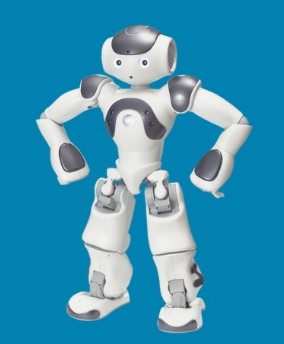| Looking Forward To NAO 7 |
| Written by Lucy Black | |||
| Sunday, 03 November 2024 | |||
|
Introduced to the world in 2004 by its creator Bruno Maisonnier the kid-sized, autonomous humanoid robot NAO, turns 20 this year. At less than 2 ft tall, it is small in stature, but plays a big role in the areas of education, research, entertainment and football. Here we look forward to NAO 7, its seventh generation. NAO was adopted as the robot used as the Standard Platform robot for RoboCup in 2007. Although at first it was rather clumsy and had a tendency to fall over, thanks to the efforts of university students around the world NAO's has developed the ability not only to kick a ball but also to recover from a fall without assistance. Recent research has focused on giving it a more human-like gait, see NAO Robot Footballers Work On Walking. We initially met NAO in 2011 when, in its 4th generation it had gained the ability to seek out and return to its charging station, an important skill for an autonomous robot. We then followed NAO's progress as "he" learned to pick up socks, play Hangman and Connect Four and act as a teaching assistant with autistic children, who were able to relate remarkably well to the kid-sized robot. We were also entertained by Nao playing the Xylophone, learning to dance and improving his footballing skills in successive years RoboCups. However, after Aldebaran was sold to Softbank we rather lost touch, apart from RoboCup, even though NAO continued to evolve and to be important in robot research by virtue of being commercially available. Its ability to interact with humans in a natural and engaging way has given it an role in education and entertainment. This video from Aldeberan look forward to NAO's 7th Generation which is "coming shortly". Seven improvements are mentioned in the video. They include a smart touch screen, an upgraded head, an enhanced microphone, and advanced motor system and an enhanced battery - all pretty general. The two specific improvements are the addition of a fourth finger which will significantly enhance its dexterity and manipulation capabilities. With four fingers instead of three, NAO will be able to perform tasks that were previously beyond its capabilities.
The other significant addtion to NAO 7 is a billed as "Tibia TOF Sensor". A Time-of-Flight (TOF) sensor is a device that measures distance by emitting pulses of light and measuring the time it takes for the reflected light to return to the sensor. This technology allows for precise distance measurements, even in low-light conditions. Installing this sensor on the tibia (shin bone) could be used for various purposes, such as:
Overall, the inclusion of a TOF sensor on the tibia of NAO 7 suggests a significant advancement in the robot's capabilities, enabling it to navigate its environment more effectively and interact with humans in more sophisticated ways. More InformationRelated ArticlesNAO Robot Footballers Work On Walking NAO's Creator Quits Aldebaran As Pepper Goes On Sale NAO Works With Autistic Children Robots As Dancers - The Nao Dance Troupe New Nao robot and $15 million investment Nao Strikes a Blow for Robot Independence To be informed about new articles on I Programmer, sign up for our weekly newsletter, subscribe to the RSS feed and follow us on Twitter, Facebook or Linkedin.
Comments
or email your comment to: comments@i-programmer.info |
|||
| Last Updated ( Sunday, 03 November 2024 ) |



